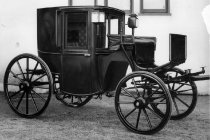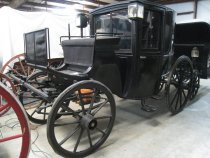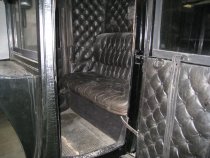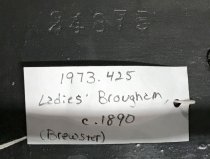Object Record
Images




Metadata
Title |
Brougham, 1903 |
Object Name |
Brougham |
Description |
Brougham, 1903. This example has a square arch panel and a comparatively small body. It has a hand brake at the coachman’s seat and square lamps. The interior is tufted leather with leather covered drop handles and pockets at the sides. There is a plate attached to the door that covers the step to the interior. When the door is open, any dirt or mud accumulated while the vehicle was in motion is on the cover plate. The interior features a pebble skin-covered vanity with a watch case and umbrella holder. A wool carpet covers the blue, yellow and black floor cloth. It has silk roll up shades for privacy. The Brewster specification records list this as a "Standard Medium Brougham." Its fabrication started in 1903 and it was sold to William Bowers Bourne in December 19, 1904. The entire vehicle was painted black and the interior was trimmed with "pebbled" (a grain configuration) leather with plain black carpet in the interior, and black plain cloth/wool broadcloth on the exterior seats. The footboard had a rubber mat. It was sold with a driving apron and seat covers. Part of the San Mateo County Historical Association's carriage collection. |
Date |
1903 |
Creator |
Brewster & Company, NY |
Role |
Manufacturer |
Catalog Number |
1973.425 |
Dimensions |
H-77.5 W-67 D-131 inches |
Collection |
3D - Land Transportation Tools & Equipment |
Inscription Text |
"24875" (stamped into wooden seat and elsewhere) |
Provenance |
-Sold to William Bowers Bourne in December 19, 1904. -The Roth Collection is particularly significant as all of the carriages were built by one of the two Brewster firms in New York City, producers of the finest quality vehicles for America's leading families. The National Carriage Association in Staten Island has the original records of the Brewster Company. Since Roth carriages were produced for use in California, they evidence some special changes to adapt them to their owner's way of living. As of June 10, 1973, each carriage was in superb condition, never having been restored. Each carriage bears an individual registration number from the factory. The carriages were built almost entirely of wood, and many coats of paint were applied, each coat rubbed and polished until it was mirror-smooth. As the paint of that era dried slowly, there often was more than a week's wait between the application of coats. |
Notes |
The Brougham was a type of enclosed carriage collaboratively designed by Lord Henry Peter Brougham and his coach maker, Robinson. Broughams were designed to be pulled by a single or pair of horses and had removable splinter bars that fitted for use with a pole for a pair of horses or removed and replaced with shafts for a single horse. By the middle of the 19th century, like the Coupé, these vehicles were popular formal types among wealthy Americans. They were driven by a coachman, accompanied by a groom, and used in towns and cities. The interiors were often sumptuous, and fitted with amenities such as clocks, visiting card cases, vanities and call bells. There were many styles of Broughams, from small "Bachelor Broughams" to Country Broughams that had a removable upper rear quarter panel. [Carriage Consultant Merri Ferrell 8/31/2021] "Brewster & Co. was founded by Henry Brewster, a son of James Brewster, a noted early-19th-century carriage builder at New Haven. Henry Brewster's firm was founded in 1856 and was first known as Brewster of Broome Street, New York, but changed the name to Brewster & Co. when its main office was moved to Broadway and 47th Street in 1874. Under the direction of John W. Britton, one of the partners in the firm, Brewster & Co. became the leading builder of high-class carriages in the U.S., and enjoyed the custom of most of the prominent personalities in New York society and elsewhere." [https://carriageassociationofamerica.com/carriage-tour/stanhope-gig/ 08/02/2018] "The prototype of the brougham was designed by Lord Peter Henry Brougham of England in 1838 and made by the London coach builder Robinson. These four-wheel enclosed vehicles for two or more passengers remained popular throughout the Carriage Era in Europe and the United States. Broughams were also used as public cabs for hire." [Museums at Stony Brook. The Carriage Collection. Stony Brook, New York: The Museums at Stony Brook, 1986. p.57] |
Search Terms |
Carriage Carriages Filoli Horse Drawn Vehicles Roth, Lurline Matson Roth, William P (Mrs.) Transportation |
Subjects |
Carriages & coaches Coach drivers Transportation |
People |
Roth, Lurline Matson Roth, William P. Mrs. |
Credit line |
Courtesy of Mrs. William P. Roth |
